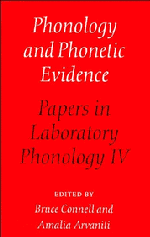Book contents
- Frontmatter
- Contents
- List of contributors
- Acknowledgments
- 1 Introduction
- I Features and Perception
- II Prosody
- 8 Stress shift: do speakers do it or do listeners hear it?
- 9 The phonology and phonetics of the Rhythm Rule
- 10 The importance of phonological transcription in empirical approaches to “stress shift” versus “early accent”: comments on Grabe and Warren, and Vogel, Bunnell, and Hoskins
- 11 Perceptual evidence for the mora in Japanese
- 12 On blending and the mora: comments on Kubozono
- 13 Toward a theory of phonological and phonetic timing: evidence from Bantu
- 14 On phonetic evidence for the phonological mora: comments on Hubbard
- III Articulatory Organization
- Subject index
- Index of names
- Index of languages
14 - On phonetic evidence for the phonological mora: comments on Hubbard
Published online by Cambridge University Press: 03 May 2011
- Frontmatter
- Contents
- List of contributors
- Acknowledgments
- 1 Introduction
- I Features and Perception
- II Prosody
- 8 Stress shift: do speakers do it or do listeners hear it?
- 9 The phonology and phonetics of the Rhythm Rule
- 10 The importance of phonological transcription in empirical approaches to “stress shift” versus “early accent”: comments on Grabe and Warren, and Vogel, Bunnell, and Hoskins
- 11 Perceptual evidence for the mora in Japanese
- 12 On blending and the mora: comments on Kubozono
- 13 Toward a theory of phonological and phonetic timing: evidence from Bantu
- 14 On phonetic evidence for the phonological mora: comments on Hubbard
- III Articulatory Organization
- Subject index
- Index of names
- Index of languages
Summary
Introduction
Recent studies in phonological theory have conferred upon the mora a truly essential role, to the exclusion of other theoretical constructs such as labeled syllable constituents (onset, rime, nucleus, coda) or segmental slots (C/V or X-slots) (cf. work on Moraic Theory by Hyman, 1985, McCarthy & Prince, 1986, Zee, 1988, Hayes, 1989, and Steriade, 1990, among others). Hubbard's paper can be viewed as falling within this research paradigm, but on the phonetic side of linguistic investigation. With her proposal that the phonological mora plays a primordial role in the phonology/phonetics interface in Bantu languages, Hubbard draws attention to a new type of evidence for Moraic Theory; she adds phonetic timing to the phonological and morphological arguments traditionally given in support of the mora.
Summary of Hubbard' s main points
Hubbard provides two related sources of evidence for the existence of a correlation between the phonological mora and phonetic timing (section 13.2). First, her measurements and statistical tests indicate that “the effect of mora count [on the total duration of a word in Runyambo and Luganda] is more important than syllable count”. Thus, as illustrated in Table 14.1 with Runyambo data (taken from Hubbard's Table 13.1), “words with the same mora count have very comparable duration”, even if they differ in syllable count, while words with the same syllable count have significantly different durations when they differ in mora count.
- Type
- Chapter
- Information
- Phonology and Phonetic EvidencePapers in Laboratory Phonology IV, pp. 188 - 202Publisher: Cambridge University PressPrint publication year: 1995

